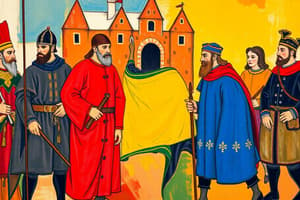Podcast
Questions and Answers
What was the primary way that lords granted power to vassals?
What was the primary way that lords granted power to vassals?
- Through a system of taxation
- Through a system of trade and commerce
- Through the granting of fiefs (correct)
- Through a system of elected representatives
What was the primary responsibility of a vassal to their lord?
What was the primary responsibility of a vassal to their lord?
- To collect taxes for the lord
- To manage the lord's estate
- To provide counsel and guidance
- To provide military service and loyalty (correct)
What was the result of feudalism on medieval society?
What was the result of feudalism on medieval society?
- It led to the elimination of the noble class
- It led to a more centralized system of government
- It led to a more decentralized system of government (correct)
- It led to the eradication of social classes
What was a key characteristic of the feudal system?
What was a key characteristic of the feudal system?
What was the social hierarchy of the feudal system like?
What was the social hierarchy of the feudal system like?
What was the primary role of a lord in the feudal system?
What was the primary role of a lord in the feudal system?
What was the result of the feudal system on social mobility?
What was the result of the feudal system on social mobility?
What was the primary economic system of the feudal period?
What was the primary economic system of the feudal period?
What was the impact of feudalism on medieval culture?
What was the impact of feudalism on medieval culture?
What was the role of homage in the feudal system?
What was the role of homage in the feudal system?
Flashcards are hidden until you start studying
Study Notes
Feudalism
Definition
- A decentralized system of government and social hierarchy that emerged in Europe during the Middle Ages
- Characterized by a network of obligations and dependencies between lords and vassals
Key Components
- Lord: A noble who owned land and held power
- Vassal: A lesser noble who received land and protection from a lord in exchange for loyalty and military service
- Fief: A parcel of land granted to a vassal by a lord
- Homage: An oath of loyalty sworn by a vassal to a lord
How it Worked
- Lords granted land: Lords granted fiefs to vassals in exchange for loyalty and military service.
- Vassals provided service: Vassals provided military service, counsel, and other forms of support to their lords.
- Lords protected vassals: Lords protected their vassals and their lands from external threats.
- Vassals owed loyalty: Vassals owed loyalty to their lords and were expected to provide service when called upon.
Characteristics
- Decentralized power: Power was decentralized, with lords and vassals holding significant autonomy
- Social hierarchy: A strict social hierarchy existed, with lords at the top and vassals below
- Economic system: The feudal system was based on a system of obligations and dependencies, rather than a monetary economy
Impact on Medieval Society
- Stabilized society: Feudalism helped to stabilize medieval society by providing a system of order and protection
- Limited social mobility: Feudalism limited social mobility, as individuals were born into their stations and were expected to remain there
- Shaped medieval culture: Feudalism shaped medieval culture, influencing the development of chivalry, heraldry, and other cultural institutions
Feudalism
Definition
- A decentralized system of government and social hierarchy that emerged in Europe during the Middle Ages
- Characterized by a network of obligations and dependencies between lords and vassals
Key Components
- Lord: A noble who owned land and held power
- Vassal: A lesser noble who received land and protection from a lord in exchange for loyalty and military service
- Fief: A parcel of land granted to a vassal by a lord
- Homage: An oath of loyalty sworn by a vassal to a lord
How it Worked
- Lords granted land to vassals in exchange for loyalty and military service
- Vassals provided military service, counsel, and other forms of support to their lords
- Lords protected vassals and their lands from external threats
- Vassals owed loyalty to their lords and were expected to provide service when called upon
Characteristics
- Decentralized power: Power was decentralized, with lords and vassals holding significant autonomy
- Social hierarchy: A strict social hierarchy existed, with lords at the top and vassals below
- Economic system: The feudal system was based on a system of obligations and dependencies, rather than a monetary economy
Impact on Medieval Society
- Stabilized society: Feudalism helped to stabilize medieval society by providing a system of order and protection
- Limited social mobility: Feudalism limited social mobility, as individuals were born into their stations and were expected to remain there
- Shaped medieval culture: Feudalism shaped medieval culture, influencing the development of chivalry, heraldry, and other cultural institutions
Studying That Suits You
Use AI to generate personalized quizzes and flashcards to suit your learning preferences.




